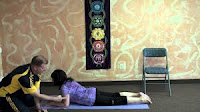By: Virginia
Iversen, M.Ed
One of
the most creative and rewarding aspects of being a professional Yoga teacher,
is the opportunity to sequence your classes in such a way that you allow your
students to deeply benefit from this transformational, ancient practice. There
are many different themes and intentions that can underlie your choice of
various Yoga postures, breathing exercises and meditation techniques that you
offer to your students. One guiding theme for choosing a certain series of
asanas, pranayama practices and relaxation techniques during the course of a
Yoga class, is to use the cues of the earth around you, including the wisdom of
the changing seasons.
As I
write this article, the brilliantly colored leaves of the fall season are
gently wafting through the air and settling into patterns along the ground.
This is the time of the year in the Northeastern United States when the
deciduous trees around us burst into brilliant colors, and then gently drop
their leaves to the earth below. As the trees release their leaves to the
earth, the seeds below are softly ensconced in a blanket of colorful foliage.
By taking into consideration the seasonal aspects around you when you are
creating a sequence of poses to teach during a Yoga class, you will help to
facilitate your students’ awareness of the flow of the seasons, and you will
also help to align and infuse their practice with the wisdom of the natural
rhythms of the earth.
In the
autumn season, both the energy of fullness and release are accentuated. A
wonderful way to honor this natural rhythm is to teach Yoga classes that open
the heart. By opening the heart, your Yoga students will be more able to
release muscular tension, negative emotions and rigidly held thought patterns
that tend to reside both in the front and the back of the heart chakra, and
also in the shoulder, neck and throat areas. When these areas of tension are
released, the life force energy is more able to flow unimpeded throughout the
entire body and mind. This enhanced flow of prana will facilitate the detoxification
process, as well as energize and nourish your Yoga students.
* Sphinx
Pose
Sphinx
Pose is a very accessible, beginning heart-opening Yoga posture that most
students can safely and effectively practice. Sphinx Pose can be practiced
either during the initial portion of a Yoga class, when your students are
flowing through a series of Sun Salutations, or it can be practiced after a
series of standing postures and balancing poses. Sphinx Pose effectively opens
up the front and the back of the heart area and increases the flow of blood and
fresh oxygen throughout the abdominal region. This gentle back bending posture
also releases tension in the front of the throat and the back of the
shoulders.
When you
are ready to teach your students Sphinx Pose, have them come to a prone
position on their Yoga mats and rest for a moment with one cheek flat on the
mat. When they are ready, with their next inhale ask your students to place
their elbows directly underneath their shoulders with their fingers pointing straight
ahead, as they expand fully into Sphinx Pose. As they hold the posture, remind
your students to keep their elbows in line with their shoulders and the palms
of their hands flat on the mat. Instruct your students to continue to breathe
slowly and deeply, as they gently press the palms of their hands against the
Yoga mat and progressively expand their heart area with each successive
inhalation.
Ask your
students to hold Sphinx Pose for 3 to 5 complete breath, and then release the
posture with their next exhale and rest the alternate cheek flat on the Yoga
mat. When they are ready, repeat Sphinx Pose two more times. At the end of
their practice of Sphinx Pose, you may want to recommend that your students
slowly move back into Extended Child's Pose, in order to release any tension
that may have built up in the lower back area, during the practice of this
gentle back bending posture. Before continuing on to the next Yoga posture, ask
your students to come to a kneeling position on their mat and quietly reflect
on the expansive quality of Sphinx Pose.
Virginia Iversen, M.Ed, has been practicing and studying the art of Yoga for over twenty years. She lives in Woodstock, New York, where she works as a writer and an academic support specialist. She is currently accepting Yoga and health-related writing orders and may be contacted at: enchantress108@gmail.com.
© Copyright 2015 – Virginia Iversen / Aura Wellness Center – Publications Division
Please feel free to share our posts with your friends, colleagues, and favorite social media networks.





